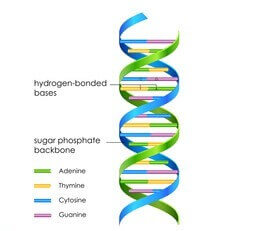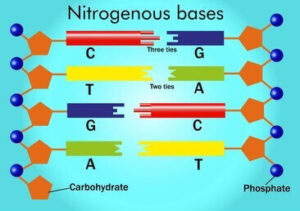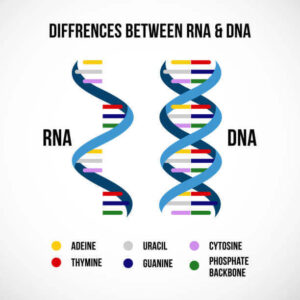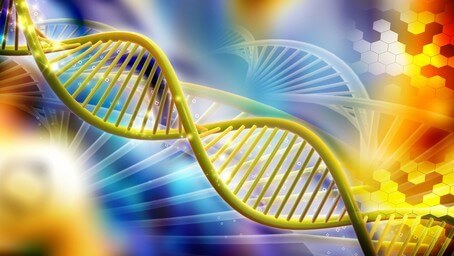What Is Gene : A Hereditary Unit In Genetics
What Is Gene
What is a gene? Have you ever heard about you, that you look like your mom/dad or any other person in your family or any quality or trait ( your eye colour, behaviour, your curly hair, texture even how you smile) you have, that resemble your family member?
Did you ever think, about it, how it happens? Which is responsible for that?
Yes, You are right. That is a gene, which is responsible for all the above things.
CONCEPT OF GENE –
Gene is the hereditary unit and is responsible for inheritance. It is also known as a functional unit on the basis of molecular structure.
A lot of importance of the gene concept is there because its physical and chemical nature is the foundation stone of all genetic principles. Genes are catalyst*, which brings about reaction without being changed or consumed.
Basically, the gene is a part of DNA and is made up of Nucleotides. A gene can grow, reproduce and mutate*.
Genetic information is conveyed from DNA to mRNA. The term gene was coined by Johanson.
DEFINITION OF GENE –
Gene can be defined as ;
Ultimate unit of recombination, mutation and self-reproduction.
Or
Gene is a macromolecule attached to undifferentiated protein thread ( chromonema) that can pass from one cell to another and can be transmitted from one generation to another without being changed at all.
“ Gene(DNA) determines all characteristics of an organism and contains all the genetic material that makes us who we are. This information is passed on from generation to generation in a species so that the information within them can be passed on for the offspring to harness in their lifetime”.
Now we get into more detail about how this genetic information is passed on.
LOCATION OF GENES –
Genes are located on the chromosomal thread which runs along the entire length of the chromosome. The total number of genes present on haploid set chromosomes represents one genome. Genes are very fine structures, these are very difficult to measure directly.
Each gene occupies a specific position in a specific chromosome. This specific position is called Locus.
Genes are situated in chromosomes and are arranged in linear sequence like beads on a string at a fixed distance.
CHEMICAL ANALYSIS –
Chemically gene contains DNA as primary components. Genes act mainly by producing protein. Which required various steps of metabolism.
Proteins are made up of a polypeptide chain of amino acids. Arrangements of amino acids determine the different types of protein.
STRUCTURE OF DNA (GENE) –
DNA is arranged into a double helix structure. Where spirals of DNA are intertwined with one another, continuously bending in on itself but never getting closer or further away.
Chromosomes are made up of nucleo-proteins which constitute basic proteins and nucleic acids. Two kinds of nucleic acids are recognized: DNA ( Deoxyribose nucleic acid ) AND RNA( Ribose nucleic acid ).
DNA is a storehouse of genetic material. It transmits information to RNA. Both are recognized on the basis of pentose sugar and nitrogenous base, responsible for forming nucleotides.
STRUCTURE OF DNA –

DEOXY RIBONUCLEOTIDES
Nucleotides constituting the DNA are called Deoxyribonucleotides. Each Deoxyribonucleotide consists of Deoxyribose sugar, Nitrogenous base and Phosphoric acid.
- Deoxyribose Sugar–in DNA Deoxyribose Sugar is present as compared to that of Ribose type found in RNA.
- NITROGENOUS BASES-they are of two types-
1)Purines –Adenine and Guanine
2)Pyrimidenes – Thymine and Cytosine.
In RNA, Uresil replaces the Thymine.
NUCLEOSIDES –
Nucleosides are formed by a Purines or Pyrimidine Nitrogenous base and Pentose Sugar. A Nitrogenous base is linked to a Pentose Sugar through an N- Glycosidic linkage to form Nucleoside. DNA Nucleosides are known as Deoxyribonucleosides.
NUCLEOTIDES-
In Nucleotides, Purine or Pyrimidine Nitrogenous base is joined by Deoxyribose Pentose Sugar, which is further linked with Phosphate group to form nucleotides. The length of DNA represents the number of Nucleotides( or a pair of nucleotides referred to as a base pair).
There are four different types of nucleotides in the DNA sequence –Adenine, Cytosine, Guanine and Thymine( can be written as ‘A’, ‘C’, ‘G’, ‘T’). There are billions of nucleotides in our Genome. All these possible permutations make us unique.
RULES FOLLOWS TO NUCLEOTIDES TO PAIR WITH ONE ANOTHER –
1) There are four possible types of Nucleotides-Adenine, Cytosine, Guanine, Thymine.
2) Thymine and Adenine can only make up a base pair.
3) Guanine and Cytosine can only make up a base pair.
4) Therefore, Thymine and Cytosine would never make a base pair as in the case of Adenine and Guanine. This continuous sequence determines an organism’s structural, physical and anatomical features.

( diagram of the double-helical structure of DNA shows )
Sugar –phosphate backbone +base pair+ sugar-phosphate backbone
DIAGRAM OF NUCLEOTIDES
The above diagram shows, how the Nitrogenous base( Adenine and Thymine )are attached by Double Hydrogen Bond and( Cytosine and Guanine )are attached with Triple Hydrogen Bond. They are further linked to Deoxyribose Sugar and Phosphate group in Nucleotides.
TYPES OF DNA –
On the basis of the number of base pairs and tilted from the axis of the helix, DNA has various forms like A, B, C, D, Z DNA.
PROPERTIES OF GENETIC MATERIAL (DNA versus RNA) –
DNA is the major hereditary material in most organisms. RNA mainly performs the functions of messenger and adapter. This difference is due to the chemical structure of DNA and RNA. Some required properties of genetic material are following.

Replication-
This refers to duplication of its genetic material by faithful replication, which is shown only in DNA and RNA, not in proteins and other molecules present in living organisms.
Stability
The stability of genetic material should exist. It should not change its structure easily with changed stages of life, age of physiology of living beings.
In Griffith experiment of ‘Transforming Principles’DNA survived in heat-killed bacteria, both strands of DNA are complementary with each other and can be separated. RNA is easily degradable due to the presence of its 2 –OH group present in its every nucleotide.
Therefore DNA is called better genetic material than RNA. The presence of Thymine instead of Urasil makes it more stable.
Mutations-
Genetic material should be able to undergo mutations and such a change should be stably inherited. Both nucleic acid DNA and RNA have the capacity to mutate. RNA mutates at a faster rate as compared to DNA.
Genetic expressions-
RNA expresses easily the characters in the form of protein. DNA requires RNA for the formation of proteins. DNA being more stable is considered better than RNA for storing genetic material.
On the other hand, for the transmission of genetic characters, RNA gives better results.
GENE MUTATIONS-
Gene or point mutations are stable changes in genes i.e. DNA chain. Although each gene is a potential site for a mutation, yet some genes mutate more frequently than other genres. Such mutable genes are widely found in plants and animals.
The process by which new alleles of a gene are produced. The smallest part of the gene that can mutate is called muton. The smallest muton in a gene is a single base pair of DNA. So that means, mutation even occurs in a single base pair of DNA.
TAUTOMERISM – The changed pairing qualities of bases(pairing of purine with purine and pyrimidine with pyrimidine) are due to a phenomenon called Tautomerism.
SUBSTITUTIONS ( REPLACEMENTS)- When one or more nitrogenous base pairs are changed with others. It has 3 subtypes; Transitions, Tansversions and Frameshift. TRANSITIONS-
In triplet code of DNA, or m- RNA when purines replace with purines and pyrimidines replaces with a pyrimidine.
TRANSVERSIONS-
In this type of mutation, when Purines( Adenine, Guanine) replaces with Pyrimidines and Pyrimidine ( Cytosine and Thymine, Uresil )replaces with Purines.
FRAMESHIFT-
In this type of mutation, Additions and Deletion of a single Nitrogenous base takes place. Also, genes are displayed twice on the same chromosome due to duplication.
In Deletion, genes of the chromosomes are permanently lost after they unattached from the Centromere( central part of a chromosome).
For example, a gene coding for Alanine Amino Acids, with a genetic sequence of C-G-G and the Cytosine Nucleotide was deleted, then the Alanine Amino Acids would not be created. Other Amino Acids supposed to be coded for this DNA sequence will also not be produced.
POINT MUTATION-
Gene mutation, that involves Substitution, Deletion, or Insertion of a single base pair are called Point Mutation.
GROSS MUTATION-
Which involves Substitution, Deletion and insertion of more than one base pair or entire genes are called Gross Mutations.
Catalyst*- a substance, that can increase the chemical reaction without being consumed. Enzymes are proteins, which acts as a catalyst.
Mutate*- Which causes mutation. i.e. include all those heritable changes which change the phenotype(morphology ) and genotype ( chemical structure on a molecular level )of an individual.
are explained in diagrams.
If readers want to know about any topic in detail, kindly let me know by writing in the comment section.
Also read- Essay on Air Pollution
Thank you
